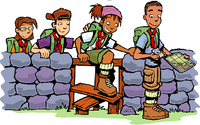
HIKING

 |
HIKING |
 |


1. Compile lists of the personal equipment needed for a hiking expedition of at least three days. Present yourself, properly dressed and packed, before going on an overnight hike. Discuss your choice of clothing, equipment, rations and emergency kit.
Clothes2. Discuss what is meant by individual hiking skills (pace, rhythm, foot placing, conservation of energy, balance and co-ordination); personal hygiene; the Outdoor Code; wilderness manners; minimum impact hiking and camping. Demonstrate how these are applied in the outdoors. Understand the importance and correct way of using catholes away from water, paths and campsites, when other latrines are not available.
For most of these I will leave them to you to workout, as the meanings behind each will came to you as you gain experience in each. I however will touch on a few items such as Catholes. It is important to when using a cathole (a hole dug about 30 deep for a use as a toilet) to make sure it is at least 100m away from a river and not on a path. The idea behind the distance is that as it rains the water may wash some of it into the river if close enough and if the river is you water source, then you get the idea.3. Know the importance of the party staying together, and the procedure to be followed in the event of an accident or emergency. Know the signs and symptoms of hypothermia (exposure), the precautions to be taken to avoid this, and the correct treatment of hypothermia.
Hypothermia or Exposure4. Know the procedure governing access to nature conservation areas, Parks Board areas, National Hiking Way trails and wilderness areas. Explain what permission is required before setting out on a hike (permits, parent consent etc) and the correct procedure when crossing private property.
Different place will have different requirements. Therefore, you need to find out what the rules are before you plan the hike. National Conservation area have maximum number of hiker aloud in a certain area, while all parks etc have rules about fires outside of permitted areas and removal of plants, having animal, etc. From the scout side before setting out on any activity you need to fill out a activity permit and get it signed by you district commissioner at least 14 days before the activity. All scouts need to have a filled out consent form signed by one of their parents. It is important to leave contact numbers and a route plan with someone not on the hike, incase of an emergency.5. Show that you can use a compass and how to orientate and use a 1:50 000 topographical map. Be able to locate your position by reference to natural features. Identify the conventional map symbols, and demonstrate the use of scale.
For help on this requirement check out the mapping section of this website or the scout trail pg 44 - 45.6. With other Scouts (minimum of four in the party), hike 50 kilometres over country tracks, across country, or on recognised hiking trails. This is to be undertaken over no more than three separate hikes, of which no hike is shorter than 20 km. At least one overnight camp must be included. (Accommodation can be provided for in tents or huts.) A brief record of the dates, routes, distance hiked, names of party, and any other useful details, eg the weather conditions, campsite descriptions, must be presented to the examiner. The hikes must be done under a suitable leader such as the Troop Scouter, or as part of a recognised hiking organisation such as the Scout Mountain Club or Mountain Club of South Africa.
Download some items to help you with writing a log book from the SASA website:If you have any other question relating to the topic or any ideas to share please fell free to contact the webmaster at: 200502654@ufh.ac.za